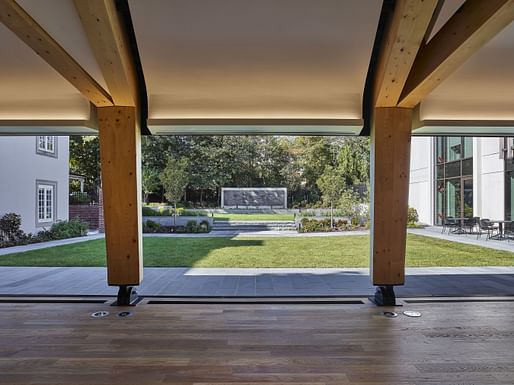
Fentress Architects’ AIA chapter award-winning Chancery restoration project for the Embassy of Norway has officially opened to the public, representing a first for the 42-year-old Denver-based firm.
Situated between the official Vice Presidential Residence and National Cathedral in Washington, D.C.’s Embassy Row neighborhood, the project’s scope entailed the restoration of an original structure from 1905 in addition to a 30,000-square-foot expansion aimed at making the complex more sustainable, modern, and accessible.
The firm says this was all done along the guiding Norwegian principles of Handlekraft (vigor), Arbeidsglede (joy of work), Profesjonalitet (professionalism), and Åpenhet (openness).
Per Fentress: “The result is a transformed Chancery comprised of three elements: a stone shell, a cocoon, and a copper-clad mass timber hull. The mass and forms of the limestone-clad stone shell are deliberately segmented and scaled to show deference to the Ambassador’s residence and blend harmoniously with the historic residential neighborhood. While the vast majority of the existing structure and limestone cladding were retained and restored, strategic interventions were made to the stone façade in order to open up new views of the garden and public street, block undesired views from neighbors, and introduce generous daylight within.”

“Diplomatic spaces are demarcated and celebrated with the help of a copper-clad mass timber hull. Wrapped in copper, an open, gracious, and accessible new entry to the Embassy results from lowering the original lobby structure seven feet and eliminating an associated obtrusive staircase. Copper cladding recalls Norway’s gift of copper for the Statue of Liberty. Adjacent to the entry is Atlantic Ocean Hall, which incorporates the old garden wall, and for which underutilized courtyard space was captured.”
“The wood-finned curtainwall cocoon wraps internal elements including the lobby atrium and Social Hub as well as extrudes externally to screen rooftop elements. A two-story space, known as the 'Social Hub,' is connected by an open stair and functions as a venue for staff to engage in intellectual dialogue and build community.”
According to the architects' project description, the new mass timber structure of Atlantic Ocean Hall “recalls Viking mastery of shipbuilding and woodworking. In rhythm with the historic windows, the structure’s spruce columns alternate in a triangular grid, thereby eliminating the need for additional cross-bracing and creating a dramatic, yet intimate space for Norwegian hospitality and diplomacy. The mansard form of the roof is appropriate to the neighborhood and gives the Atlantic Ocean Hall its distinctive shape.”

Fentress says sustainability was also a core tenet of its design. This element can be seen in the successful reuse of 90% of the embassy’s existing structure, and is further expressed by the inclusion of bioretention planters, underground EV charging stations, all-new low-e double-glazing to enhance the building’s envelope, and fritted skylights that result in a projected energy cost savings of 21.8-percent over the ASHRAE-90.1 baseline, according to the architects.
No Comments
Block this user
Are you sure you want to block this user and hide all related comments throughout the site?
Archinect
This is your first comment on Archinect. Your comment will be visible once approved.